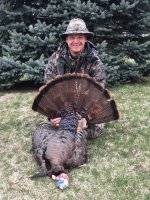A5 Sweet 16
Well-known member
So a couple of us got sidetracked, as usual, & started discussing TSS in one of the bismuth threads. KEOutdoors, who has some experience with TSS, says most, if not all, TSS pellets should pass through a bird shot under 60 yds. I THINK he was generalizing, but could've been talking about a particular goose load that uses 7s &/or 8s. I'm not entirely sure.
But regardless, I was talking to a guy last night who, it turns out, has shot a fair number of pheasants with #9 TSS. After doing so, he's not a fan, because he says each bird ends up with quite a few pellets in it. He says the #9s cause very little bleeding & don't drag feathers into the bird, so they're hard to see when cutting up the meat in preparation for cooking. He said in the birds he's eaten, they've probably found (with their teeth!) about 15 pellets PER BIRD, just in the breast & thigh meat.
I really don't know how similar a pheasant body is to 10% ballistic gel, but let's assume they're fairly similar. I'm guessing the average pellet needs to pass through about 3" of body (gel) to pass completely through a pheasant. If I'm anywhere close with that guess, & KPY Shotshell Ballistics is fairly accurate, then most #9 TSS will only pass through the body of a pheasant out to roughly 20 yds. They'll only pass through 1.5-1.75 inches at 60 yds. Again, I'm just playing around with the program & have only a vague notion that I'm on track with my assumptions.
Any of you others who've used TSS....what has been your experience with pellets in your meat?
But regardless, I was talking to a guy last night who, it turns out, has shot a fair number of pheasants with #9 TSS. After doing so, he's not a fan, because he says each bird ends up with quite a few pellets in it. He says the #9s cause very little bleeding & don't drag feathers into the bird, so they're hard to see when cutting up the meat in preparation for cooking. He said in the birds he's eaten, they've probably found (with their teeth!) about 15 pellets PER BIRD, just in the breast & thigh meat.
I really don't know how similar a pheasant body is to 10% ballistic gel, but let's assume they're fairly similar. I'm guessing the average pellet needs to pass through about 3" of body (gel) to pass completely through a pheasant. If I'm anywhere close with that guess, & KPY Shotshell Ballistics is fairly accurate, then most #9 TSS will only pass through the body of a pheasant out to roughly 20 yds. They'll only pass through 1.5-1.75 inches at 60 yds. Again, I'm just playing around with the program & have only a vague notion that I'm on track with my assumptions.
Any of you others who've used TSS....what has been your experience with pellets in your meat?


